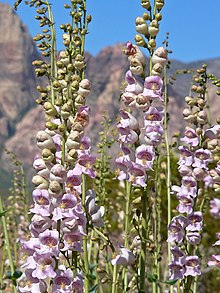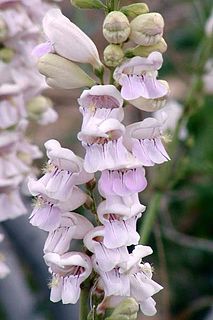
Penstemon, the beardtongues, is a large genus of roughly 250 species of flowering plants native mostly to the Nearctic, but with a few species also found in the North American portion of the Neotropics. It is the largest genus of flowering plants endemic to North America. Formerly placed in the family Scrophulariaceae by the Cronquist system, new genetic research has placed it in the vastly expanded family Plantaginaceae.

Grindelia squarrosa, also known as a curly-top gumweed or curlycup gumweed, is a small North American biennial or short-lived perennial plant.

Penstemon strictus, the Rocky Mountain penstemon, is a penstemon with showy blue flowers.

Penstemon digitalis is a species of flowering plant in the plantain family, Plantaginaceae. The flowers are white and are borne in summer. It is native to eastern Canada and the eastern and southeastern United States. Penstemon digitalis is the most widespread species of Penstemon east of the Mississippi River.

Balsamorhiza is a genus of plants in the family Asteraceae known commonly as balsamroots. These are perennials with fleshy taproots and caudices bearing erect stems and large, basal leaves. Atop the tall stems are showy yellow sunflower-like blooms. Balsamroots are native to western North America.

Primula fragrans, synonym Dodecatheon redolens, has the common name scented shooting star. It is a species of flowering plant in the primrose family.
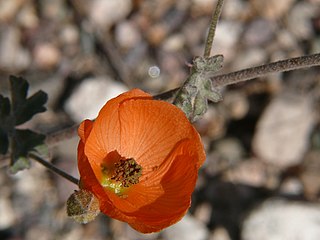
Sphaeralcea ambigua, is a species of flowering plant commonly known as desert globemallow or apricot mallow, is a member of the genus Sphaeralcea in the mallow family (Malvaceae).

Calochortus kennedyi is a North American species of flowering plant in the lily family known by the common name desert mariposa lily.

Chrysothamnus viscidiflorus is a species of shrub in the family Asteraceae of the Americas known by the common names yellow rabbitbrush and green rabbitbrush.

Lomatium grayi, commonly known as Gray's biscuitroot, Gray's desert parsley, or pungent desert parsley, is a perennial herb of the family Apiaceae. It is native to Western Canada in British Columbia, and the Western United States, including from the Eastern Cascades and northeastern California to the Rocky Mountains.

Penstemon bicolor is a species of penstemon known by the common name pinto beardtongue. It is native to the desert mountains and valleys of southern Nevada, eastern California, and western Arizona, where it grows in scrub, woodland, and other local habitat. It is a perennial herb which may exceed one meter in maximum height. The thick, serrated leaves are oppositely arranged and some pairs are fused around the stem at the bases. The inflorescence produces tubular flowers around 2 to nearly 3 centimeters long in many shades of yellow and pink, usually with striping in the throats. The flower's throat is hairy and the staminode just inside is coated in long yellowish hairs.

Penstemon floridus is a species of flowering plant in the plantain family known by the common names Panamint beardtongue and rose penstemon.

Penstemon heterophyllus is a species of penstemon known by the common names bunchleaf penstemon, foothill penstemon, and foothill beardtongue. It is endemic to California.
Penstemon pahutensis is a species of penstemon known by the common name Pahute Mesa beardtongue, or simply Pahute beardtongue. It is native to the desert hills and mountains of southern Nevada, including the Pahute Mesa for which it is named. It can also be found in a few areas over the border in California. It is a perennial herb growing up to 35 centimeters (14 in) tall. The paired, narrow leaves are linear to lance-shaped and up to 10 centimeters (4 in) long. The inflorescence bears blue-purple flowers up to 3 centimeters long. The inside of the wide mouth of the flower is lined with white or yellow hairs, and the staminode is coated in yellow hairs.

Penstemon spectabilis is a species of penstemon known by the common name showy penstemon or showy beardtongue. It is native to southern California and Baja California, where it grows in the chaparral, scrub, and woodlands of the coastal mountain ranges.
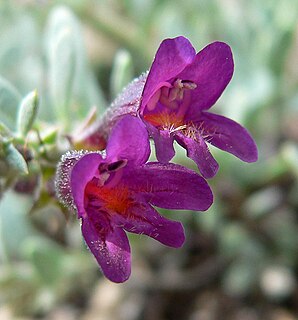
Penstemon thompsoniae, Thompson's beardtongue, is a low perennial plant endemic to the southwestern United States, where it grows in dry shrublands, woodlands and forests. It is considered a species of conservation concern in California.

Penstemon utahensis is a species of penstemon known by the common names Utah beardtongue and Utah penstemon. It is native to the southwestern United States, where it grows in scrub, woodland, and canyons. It is a perennial herb growing erect to a maximum height near half a meter. The thick leaves are located around the base of the plant and in opposite pairs along the stem. The upper leaves are lance-shaped and often folded lengthwise, measuring up to 5.5 centimeters long. The showy inflorescence bears many bright red-pink flowers up to 2.5 centimeters in length. They are cylindrical, tubular, or funnel-shaped with wide, lobed mouths, and mostly hairless to slightly hairy and glandular.
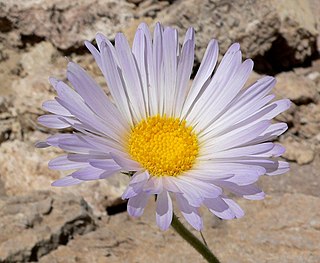
Xylorhiza tortifolia is a species of flowering plant in the family Asteraceae, known by the common names Mojave-aster and Mojave woodyaster.
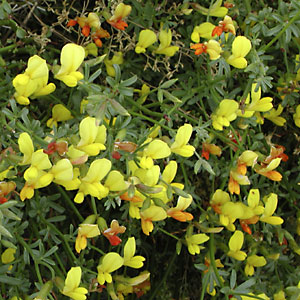
Ottleya rigida, synonyms Lotus rigidus and Acmispon rigidus, is a flowering plant in the pea family (Fabaceae), native to the southwestern United States and northwestern Mexico. It is known as shrubby deervetch or desert rock-pea. It is found in the Mojave Desert and Sonoran Desert.
